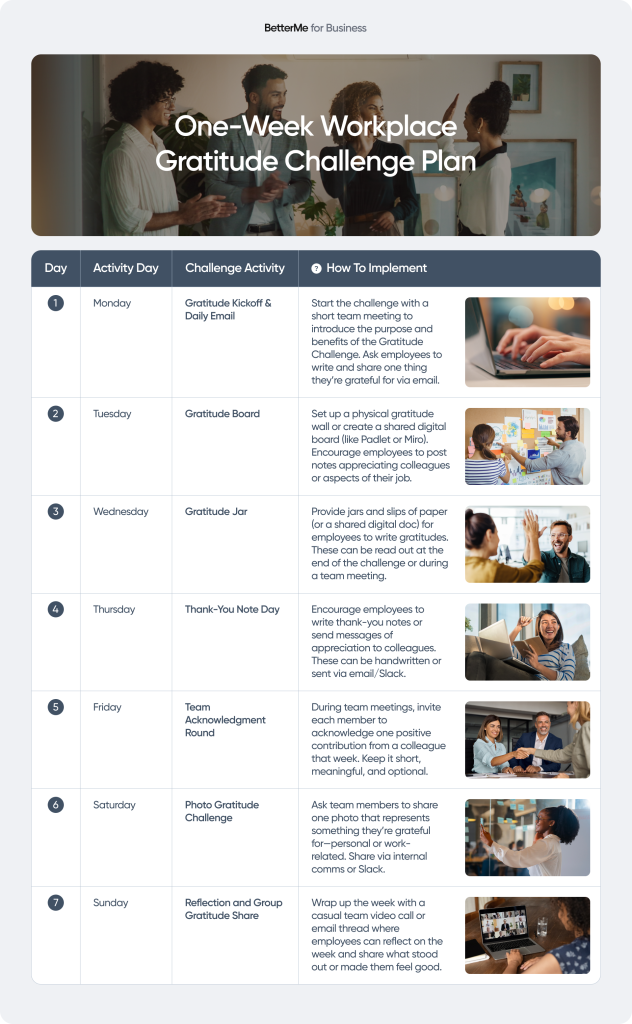When employees feel good about their jobs, they are likely to be more engaged. They communicate better, collaborate more effectively, and show a stronger commitment to organizational goals. This doesn’t just lead to better individual performance; it creates a work environment that feels cohesive and driven (1).
Shifting gears to practicalities, the question becomes: how can leaders encourage such an environment?
Gratitude might be one potential but often overlooked factor. Increasingly, researchers are uncovering its links to improved mental health and greater emotional resilience, which could enhance workplace outcomes (2, 6).
However, fostering gratitude is not about grand gestures. It’s about creating space for small, intentional practices that encourage a mindset of appreciation—not just among employees, but also among executives themselves.
Here’s what you need to know about the gratitude challenge, and how to implement it in a professional setting.
What is The Gratitude Challenge?
The Gratitude Challenge is a structured, intentional commitment to practice gratitude daily over a set period—which could be a week, a month, or more. It’s designed to prompt individuals or teams to reflect on and express appreciation for the positive aspects of their lives, work, and relationships. At its core, it encourages mindfulness toward what’s going well, rather than focusing solely on challenges or gaps.
What Are the Key Benefits of the Gratitude Challenge for Employees?
Gratitude as a practice is supported by a growing body of research in psychology. Studies show that regularly engaging in gratitude exercises, like journaling or writing thank-you notes, can enhance emotional resilience, lower stress, and improve overall mental health (2, 3).
Key evidence suggests that gratitude can even “rewire” parts of the brain to focus more on positivity. This stems from its ability to engage neural pathways associated with emotional reward and reduce activity tied to negative emotions.
For workers, the benefits extend beyond personal well-being. Research conducted with professionals reveals that gratitude interventions can result in:
1. Improved Mental Well-Being
Engaging in gratitude practices, such as journaling or group reflections, can reduce stress, anxiety, and feelings of burnout. Research shows that focusing on positive aspects of life or work shifts attention away from negative emotions (2, 3). This doesn’t “erase” challenges but helps employees build greater emotional resilience.
2. Enhanced Team Morale
Gratitude in the workplace encourages a sense of connection and belonging. Collaborative activities, like group thank-you exercises, nurture mutual respect and appreciation among colleagues. This can lead to stronger social bonds and a more cohesive team environment (4).
3. Increased Job Satisfaction
Employees who feel valued for their contributions are more likely to enjoy their work. Gratitude exercises encourage recognition of individual efforts, helping employees see the impact they have. Research correlates feelings of being appreciated with higher levels of job satisfaction (5).
Want to make gratitude a long-term habit in your team? Explore our corporate wellness programs to integrate mindfulness and gratitude into your workplace culture. Book a Free Consultation to learn how we can help your company build a stress-free and positive environment.
4. Boosted Productivity
When employees experience higher morale and reduced work-related stress, their focus and energy often improve. Gratitude practices, such as teamwide acknowledgment sessions, can create an environment where employees feel motivated and inspired to perform at their best (6).
5. Strengthened Emotional Resilience
Gratitude can act as a buffer during times of organizational stress, such as high-demand periods or change initiatives. Regular gratitude exercises teach individuals to identify and amplify what’s working well, which supports long-term emotional stability (6).
6. Greater Workplace Positivity
Over time, incorporating practices like the Gratitude Challenge helps build a positive workplace culture. Employees tend to develop habits of recognition and appreciation, which often lead to improved communication and reduced interpersonal conflicts (6).
7. Fostering Creativity
Gratitude encourages a more open mindset. Studies suggest that people are more likely to think creatively and contribute innovative ideas when they feel safe and valued in a positive work atmosphere (7).
Balancing Expectations
It’s important to note that gratitude-focused practices are not quick fixes for all workplace issues. Their efficacy depends on active participation and the alignment of these practices with overall organizational goals.
However, when thoughtfully implemented, the Gratitude Challenge offers employees a low-cost, meaningful way to increase their resilience and engagement.
This approach can be particularly beneficial in reinforcing an environment where recognition and appreciation are part of daily operations, subtly but significantly contributing to the organization’s well-being and success.
Read more: Elevate Workplace Culture with Engaging Wellness Challenges
Why Is Gratitude Important for Workplace Wellbeing?
Gratitude is more than just a feel-good practice. It has the potential to influence employee health, team dynamics, and overall workplace culture.
Encourages Psychological Safety
Gratitude fosters an environment of trust. When employees feel valued, they’re more likely to express themselves, take creative risks, and recover from setbacks. Team-based gratitude exercises, like acknowledging coworkers’ contributions during meetings, build this foundation of psychological safety (3)
Reduces Stress and Enhances Mental Health
Employees who engage in gratitude practice often report lower stress levels and better emotional well-being (3). Gratitude shifts focus to positive aspects of work life, providing a mental buffer against burnout. For example, a structured 30 day gratitude challenge can remind teams to appreciate their shared wins and individual efforts.
Strengthens Team Relationships
Combating workplace silos often starts with gratitude. Simple group activities, such as gratitude exercises for groups, can deepen connections among colleagues. Recognizing a team member’s efforts through a gratitude challenge at work fosters collaboration over competition (6).
The Workplace Wellness Trend You Can’t Ignore—Start Today
Boosts Resilience
Whether facing tight deadlines or periods of change, resilient teams tend to recover more quickly. Gratitude has been shown to improve emotional resilience by helping individuals and groups focus on strengths rather than shortcomings (2). Structured practices, like a daily gratitude huddle, can reinforce this outlook.
Encourages Employee Engagement
Employees perform better when they feel their work matters. Gratitude practices that acknowledge individual and collective achievements can increase motivation (6). For leaders, implementing consistent gratitude exercises is an effective way to sustain engagement over time.
Creates a Culture of Appreciation
Gratitude doesn’t just enhance individual wellbeing; it can transform workplace culture. Over time, incorporating practices like a gratitude challenge can embed positivity into daily operations (6). Leaders who proactively model how to practice gratitude set the tone for an appreciative workplace.
Promotes Long-Term Benefits
A sustained focus on gratitude, whether through a short team effort or a longer initiative like a 30 day gratitude challenge, can leave a lasting impact. The emphasis on recognition becomes habitual, further reducing turnover and enhancing organizational stability (8).
How to Implement the Gratitude Challenge in a Professional Setting (Office or Remote)
Integrating the Gratitude Challenge into your workplace doesn’t require complex planning. Whether in a traditional office or a remote setup, this initiative can be flexible, inclusive, and impactful. Here are some ideas worth considering:
1. Set Clear Goals and Timeframes
Decide on the scope of the challenge. Will it be a week-long engagement or a more ambitious month-long effort? Align the duration with organizational rhythms, like project cycles or quieter periods.
Clarify objectives. Are you targeting morale, collaboration, or overall employee wellbeing? These goals will guide your gratitude activities for employees.
2. Choose Accessible Activities
Offer simple exercises that encourage consistent participation. These could include:
- Daily Gratitude Emails – Employees share one small thing they’re grateful for.
- Gratitude Board at Work – Place a physical or digital space where employees can post notes about things they appreciate (e.g., kudos to a team member or recognition for a personal milestone).
- Gratitude Meditation Sessions – Hold brief guided sessions to help employees focus on positivity and decompress.
- Team Acknowledgment Rounds – During meetings, allow each participant to highlight one colleague’s contribution.
For remote teams, adapt these into virtual formats, like Slack gratitude channels or collaborative Google Docs.
Everyone’s Talking About This Gratitude Challenge—Have You Tried It? Book a Free Consultation to learn how we can help your company build a stress-free and positive environment.
3. Offer Fun and Engaging Options
Keep participation lighthearted to avoid it feeling like another task. Fun gratitude activities for adults can include:
- Gratitude Bingo – Create cards with prompts like “Thank someone from another department” or “Recognize an unsung hero.”
- Gratitude Jars – Provide jars and slips of paper for employees to write and collect gratitudes, with a group reveal at the end of the challenge.
- Photo Gratitude Boards – Encourage employees to share images that symbolize their gratitude, whether personal or work-related.
These activities allow employees to connect on a human level while reinforcing positivity.
4. Embed Gratitude into Daily Operations
Make the challenge a seamless part of your daily workflow. For instance:
- Integrate reflection prompts into meeting rituals.
- Share gratitude examples during performance evaluations to balance constructive feedback.
- Add gratitude elements to wellness tips for employees, such as pairing thank-you notes with office wellness exercises.
5. Encourage Leadership Buy-In
Leaders play a key role in influencing participation. Have managers or executives share their own gratitude examples with teams, modeling the behavior you want to foster.
6. Use Gamification for Incentives
Adding friendly competition can boost engagement. Reward teams or individuals for active participation with small tokens, such as a team coffee fund or gift cards. This not only motivates but builds team cohesion.
Read more: How to Keep Employees Engaged: Here’s What Great Managers Do
7. Measure and Reflect on the Impact
Gather feedback through anonymous surveys at the end of the challenge. Assess metrics like participation rates, employee sentiment, or qualitative comments about workplace morale.
The Bottom Line
Consistency is a critical aspect of the gratitude challenge. Structured frameworks, like this challenge, help individuals and teams form habits that are easier to sustain.
While the Gratitude Challenge offers creative ways to promote wellbeing, it is not a cure-all for workplace challenges. Pair the challenge with long-term tools like wellness programs, inclusive policies, and ongoing recognition processes.
DISCLAIMER:
This article is intended for general informational purposes only and does not serve to address individual circumstances. It is not a substitute for professional advice or help and should not be relied on for making any kind of decision-making. Any action taken as a direct or indirect result of the information in this article is entirely at your own risk and is your sole responsibility.
BetterMe, its content staff, and its medical advisors accept no responsibility for inaccuracies, errors, misstatements, inconsistencies, or omissions and specifically disclaim any liability, loss or risk, personal, professional or otherwise, which may be incurred as a consequence, directly or indirectly, of the use and/or application of any content.
You should always seek the advice of your physician or other qualified health provider with any questions you may have regarding a medical condition or your specific situation. Never disregard professional medical advice or delay seeking it because of BetterMe content. If you suspect or think you may have a medical emergency, call your doctor.
SOURCES:
- Impact of Employees’ Workplace Environment on Employees’ Performance: A Multi-Mediation Model (2022, frontiersin.org)
- Gratitude interventions to improve wellbeing and resilience of graduate nurses transitioning to practice: A scoping review (2024, sciencedirect.com)
- Effects of gratitude intervention on mental health and well-being among workers: A systematic review (2021, academic.oup.com)
- Does Gratitude Ensure Workplace Happiness Among University Teachers? Examining the Role of Social and Psychological Capital and Spiritual Climate (2022, frontiersin.org)
- Cultivating a Culture of Gratitude and Recognition Among Nurses and Staff on a Blood and Marrow Transplantation Unit (2024, nih.gov)
- Gratitude in Organizations: A Contribution for Healthy Organizational Contexts (2017, frontiersin.org)
- Does employee engagement promote innovation? The Facilitators of innovative workplace behavior via mediation and moderation (2023, nih.gov)
- Boosting Productivity Through Recognition: Simple Ideas to Shape Employee Behavior (2025, shrm.org)










